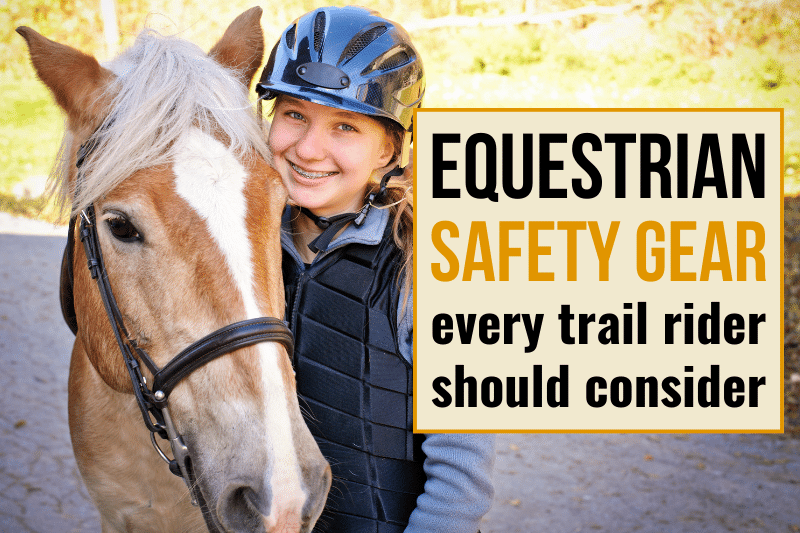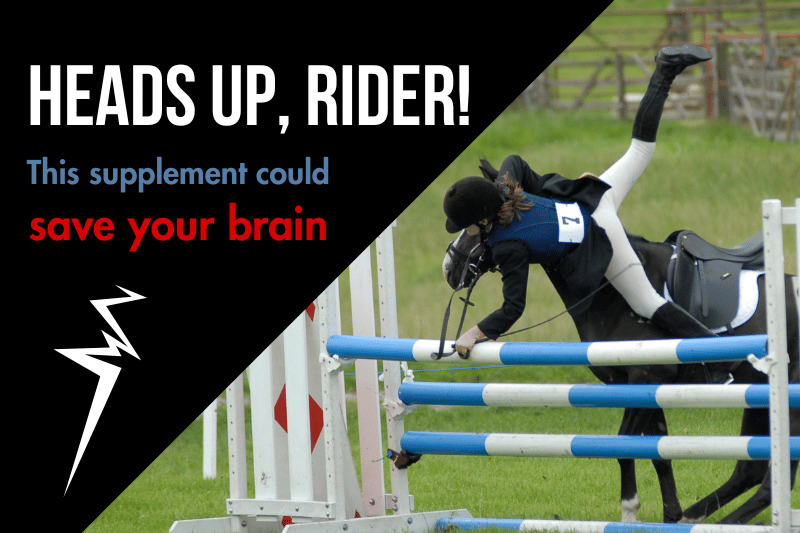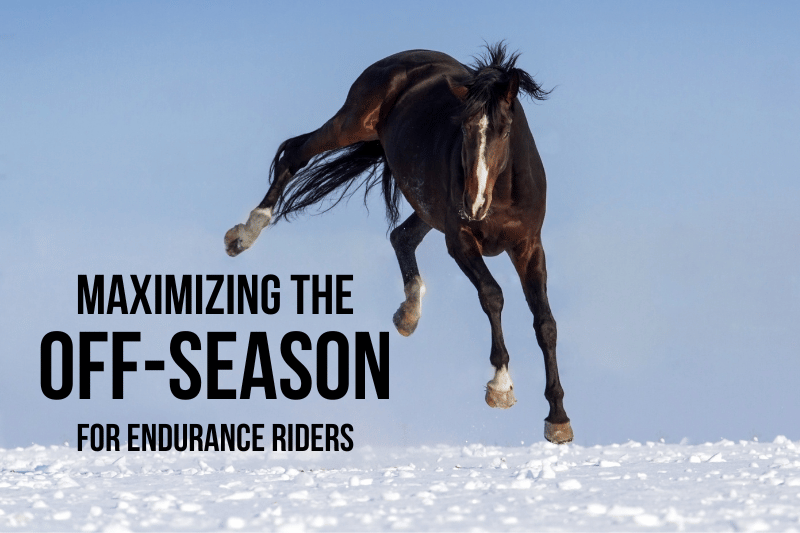Successful endurance riding means spending a lot of time conditioning our horses on trails. Many of us frequently ride alone, beyond the reach of cellular phone coverage and immediate help.
Fortunately, there are measures we equestrians can take to minimize risk when trail riding alone. These measures fall into two buckets:
- Safety gear to prevent or limit injury and
- Communication devices to facilitate rescue, if needed.
Horse Riding Safety Equipment
Safety equipment to prevent or limit injury includes protective gear and self-rescue gear. Here are some options to consider:
Helmets
First and most obviously, every rider should consider wearing a properly-fitted equestrian helmet. Within the endurance riding culture, helmet use is the norm; however, broad swaths of the trail riding community at large haven’t adopted this practice.
The fact is that head injuries are extremely common in rider falls, even when helmets are worn. However, since the same blow that causes a concussion with a helmet could mean life as a vegetable without it, I always buckle up.
MIPS Technology
My current helmet, a One K Defender, is the most comfortable I’ve ever owned. When I have to replace it, I will probably spring for an upgrade to the MIPS version.
Helmets featuring the Multi-directional Impact Protection System (MIPS) are expensive, but the technology helps prevent damage due to rotation of brain tissue within the skull. Such rotation occurs when the head comes to a sudden stop during an angled impact. Basically, a special layer in the helmet absorbs the rotational force so your brain doesn’t have to.
I haven’t tried it personally, but this EQx Kylo helmet by Charles Owen offers MIPS technology for well under $200. This uvex MIPS helmet is also on the affordable end.
Some popular helmets available at a modest price point are the Tipperary Sportage and Troxel Intrepid, both of which have saved my bacon in falls despite not having MIPS technology. Because TBI can still occur no matter how good our helmets are, I also take an inexpensive supplement to minimize the damage. (Yes, really!) Check out Creatine and TBI: A Buffer for the Equestrian Brain.
Equestrian Safety Vests
Equestrian safety vests are gaining in popularity. Some endurance riders are are even calling them the new helmets. In fact, I’ve recently added a safety vest to my own riding wardrobe.
Equestrian safety vests fall into two types: air vests and eventer vests.
Air Vests
Air vests are designed to inflate rapidly, similar to a car’s air bag, if a rider separates from her saddle. The vest clips to the saddle and in the event of a fall, the clip breaks and the vest inflates with air from a replaceable, compressed-CO2 cartridge.
Air vests like this popular Hit Air have a slim profile and include a collar pillow for neck protection. However, you can’t wear clothing over them, and they won’t deploy if the whole horse goes down along with the rider.
Personally, I went with a Tipperary Eventer Vest because I’m quick to jump off my horse in a sketchy situation. I’m sure I would accidentally deploy an air vest often.
I find the eventer vest comfortable and non-restrictive. The feeling of it bumping my cantle was a little distracting at first, but it doesn’t knock me out of position and I’ve gotten accustomed to the sensation. This Tipperary Ride Lite Vest is shorter in back so it won’t bump the cantle, but this does come at the cost of absent tailbone protection.
The downside of eventer vests is that they lack neck protection, and some models leave a gap in rib coverage where the lacing goes up each side.
Both kinds of vests do retain heat, for good (in winter) or ill (in summer), but wearing one could spare you a nasty injury.
Situational Horse Riding Safety Equipment
Brightly Colored Clothing – Bright clothing or a safety vest (the neon-colored kind with reflective tape) can make you more visible to other trail uses, whether they are out hunting for game or for a downed rider. I wear one for riding in deer hunting season and at night.
Bells – Some riders like to ride with bells on their tack to notify wildlife of their presence. I haven’t tried this, but some say it reduces spooks in deer country.
Self-Rescue Gear for Trail Riders
Consider carrying (on your body, not on the saddle) some critical items that you’re likely to need if you and your horse part ways on the trail.
My kit is designed to make hiking out or waiting for help more comfortable. I wear a running vest that holds water, energy gels, communication devices, bandaids, sunscreen, lip ointment, and painkillers. For details, check out 6 Reasons I Trail Ride in a Running Vest.
As long as you’re carrying a small pack, you might want to add a whistle. Put it on the front or shoulder of the vest for easy access, where you could use it to get the attention of a rescuer even if your mobility was limited.
Communication Devices for Horse Riding Safety
Even if you’re in an arena, you should always carry a communication device when riding alone. Again, be sure to carry it on your body, not on your saddle, so it stays with you even if the horse doesn’t.
Satellite Communication Devices for Trail Riders
A cell phone is great under most circumstances, but consider a satellite communication device if you ride beyond the reach of cell coverage.
Personally, I carry a Garmin InReach Mini as well as my phone. The Mini not only has a one-button SOS option, but it’ll Bluetooth to your phone and permit two-way messaging via satellite from just about anywhere on the planet. It also has features like map sharing and dropping “breadcrumbs” so you can retrace your steps and notify someone back home of your progress.
Garmin’s basic plan for InReach service is $12/month and allows a handful of texts plus unlimited pre-set messages like “Delayed but everything is okay” or “Pick me up here.” If you ever need to go over your custom message limit in a pinch, the cost is very reasonable.
SPOT also has a two-way satellite messaging device at a lower price point and similar monthly plan cost.
If you decide to add a satellite communication device to your riding safety equipment, be sure to practice using it regularly. Although it’s simple once you’re familiar, this is not something you want to be trying to figure out in the midst of an emergency.
Location Tracking for Trail Riders
Many riders use phone apps so friends can track their locations as they ride. I haven’t used any of these for that purpose, but here are some common recommendations:
The Find My app claims to work via satellite, without cell service, on some iPhone models.
Strava Beacon will share your location, but only when you have cell service.
The Life 360 app has both free and paid versions and includes location sharing as well as SOS. However, its features are limited beyond the reach of cell phone data networks.
Equilab also has free and paid versions, with some interesting equestrian-specific features that include location tracking using GPS, but it doesn’t appear that location updates can be sent to another person without cell service.
Fall Detection for Equestrian Safety
Some riders are also interested in fall detection technology designed to notify an emergency contact if you stop abruptly or cease all movement for a period of time.
The paid version of Equilab offers fall detection, as do many watches and fitness trackers. Depending on the device, these may only work when connected to your phone via Bluetooth, within cell range, and/or when Emergency SOS via satellite is available.
If you’re running apps for location services or fall detection, bear in mind that they may drain your phone battery more quickly than usual.
Communication for Horse Riding Safety
Not all trail riding safety measures are expensive or high-tech. Remembering the basics can go a long way toward getting you help if you need it.
Tell Someone Your Plan
Basic advice, right? But how many of us are 100% consistent in letting a reliable friend know exactly where we plan to ride and when we should be back?
If you’re riding a trail system that your safety-buddy isn’t familiar with, be sure he or she has the phone number of someone who would know what you mean by “The Coyote Loop.”
Also, be sure you’ve talked about what steps they should take if you don’t show up on schedule, as well as where you stash your spare truck and trailer keys.
Post and Carry I.C.E. Information
You never know when a good Samaritan will need to call for help on your behalf. Make sure they have the information they need by:
- Posting emergency information in obvious, unlocked locations in your barn and trailer and
- Carrying the same information both on your body and on your horse.
Your In Case of Emergency (I.C.E.) information should include more than just a family member’s phone number. If you were incapacitated, rescuers would also want to know things like which hospital network you prefer, whether you’re allergic to any medications, if you have any medical conditions, and more.
If you aren’t already carrying and posting this information, you can download my free I.C.E. Pack right now. It includes printable placards for your barn and trailer plus cards to carry on horse and rider. Duplicate information will auto-fill to make updates quick and easy.
Be safe out there!
You might also like
This post includes affiliate links, and I may earn a small commission (at no extra cost to you) when you purchase through these links. I only recommend products and services I think are helpful and useful. Thanks for helping me offset the cost of maintaining this blog as a free resource!




Anyone helmet shopping should take a look at the recent testing and resulting ratings of helmets done by Virginia Tech University’s helmet lab. They test helmets for a variety of sports, focusing on how well the helmets reduce the risk of concussions.
https://www.helmet.beam.vt.edu/equestrian-helmet-ratings.html
Excellent advice — thank you!
I use bells on my horses and my saddles, they’re called rhythm bells. Not only do they let wildlife know you’re coming, they seem to calm my horses. I think they focus on the sound and don’t spook
Uvex also has a really nice MIPS helmet at a much lower cost than most brands. It has the adjustable dial which helps with fit and its very light and airy. Plus I am pretty sure it saved my noggin when my horse hit a sinker and flipped on me last season. Highly recommend!
Interesting! Thanks for the heads up! I’ll add a link to the post.
Also tipperary also has a jockey vest similar to the eventer vest but it doesnt go down as far. It doesnt offer tailbone protection but it wont bump the cantle of your saddle
Thanks for the article.
Many reviews of the Tipperary vests criticize the zipper’s quality and failures after only a few rides. Have you experienced this issue?
Interestingly, I bought 2 Tipperary vests used, and one did come with a broken zipper (and corresponding price tag). I haven’t had trouble with one breaking yet, but they do seem wimpier than one might expect for such a high-use gear item.